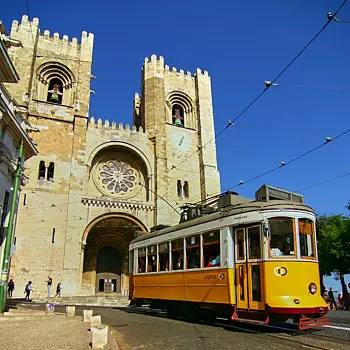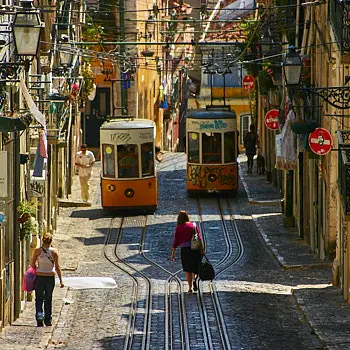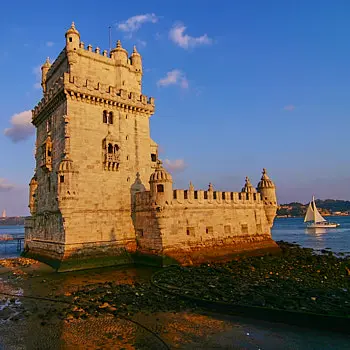If you're planning a one or two day trip to Lisbon, Portugal, you won't want to miss out on the city's top attractions and experiences. This city offers a wonderful mix of history, culture, and beautiful sights to explore. From historic landmarks to vibrant neighborhoods, this guide will help you make the most of your visit to Lisbon.

Explore the historic district of Alfama in Lisbon
Start your trip by visiting the historic neighborhood of Alfama. This charming neighborhood is known for its narrow winding streets, colorful buildings, and traditional Fado music. Take a stroll through the cobblestone streets and discover hidden gems like São Jorge Castle and the Lisbon Cathedral (Sé de Lisboa). Don't forget to stop by one of the local taverns to enjoy some delicious Portuguese cuisine and soak in the lively atmosphere. And of course, stop for a moment at the viewpoints of Miradouro das Portas do Sol and Miradouro da Graça for stunning views over the city. 😍
Enjoy panoramic views from São Jorge Castle
Perched on a hilltop overlooking the city, São Jorge Castle offers breathtaking panoramic views of Lisbon. This medieval fortress is a must-visit attraction for any visitor to the city. As you explore the castle grounds, you'll be able to admire the stunning views of the cityscape, the Tagus River, and the surrounding hills. Take a leisurely stroll along the castle walls and imagine the history that has unfolded within these ancient walls. Don't forget to bring your camera to capture the beauty of Lisbon from this vantage point. Whether you visit during the day or at sunset, the views from São Jorge Castle are sure to leave a lasting impression.
The castle in Lisbon has a rich history that dates back to the Moorish era in the 11th century when it was built as a defensive fortification. It played a significant role in Lisbon's history as a Moorish stronghold, a royal residence, and a military fortification. São Jorge Castle features a mix of architectural styles due to its long history of construction and renovation. The castle walls and towers reflect the military architecture of the Middle Ages, while the interior courtyards and structures showcase elements from different periods, including Romanesque, Gothic, and Manueline styles. The castle is surrounded by robust walls, which you can walk along to enjoy panoramic views. The towers, such as the Tower of Ulysses and the Tower of Keep, offer elevated vantage points and are often used as viewpoints. 🏰

Lisbon Cathedral
Lisbon Cathedral, also known as Sé de Lisboa or Santa Maria Maior de Lisboa, is one of the oldest and most significant religious landmarks in the city. The cathedral has a long and storied history, dating back to its original construction in 1147. It was built on the site of an ancient mosque after Lisbon was recaptured from the Moors during the Reconquista, the Christian reconquest of the Iberian Peninsula. Over the centuries, the cathedral has undergone various renovations and additions, resulting in its unique architectural blend of different styles. Lisbon Cathedral showcases a mix of architectural influences, including Romanesque, Gothic, and Baroque elements. Its façade features solid stone walls, two sturdy towers, and a rose window. The main entrance is adorned with statues of saints and biblical figures. The interior features beautiful stained glass windows and intricate tilework. ⛪
Whether you're a history buff or simply looking to immerse yourself in the local culture, a visit to Alfama is a must when exploring Lisbon.
Old Town in Lisbon
The old town in Lisbon refers to the historic center of the city, which is known as the Baixa and Chiado districts. These districts are part of the downtown area and are characterized by their charming architecture, grand squares, and historic landmarks. Baixa is the lower town and the commercial heart of Lisbon. It was completely rebuilt after the devastating earthquake of 1755 and is known for its elegant grid layout of streets. Chiado is an upscale district located between Baixa and Bairro Alto. It is known for its elegant streets, historic cafes, and literary connections.
Both Baixa and Chiado are easily walkable, and exploring their streets allows you to soak up the historic atmosphere and admire the architectural beauty of the old town. These districts also offer a range of dining options, from traditional Portuguese cuisine to international flavors. It's a wonderful area to explore, shop, dine, and immerse yourself in the captivating history and culture of Lisbon. You should explore the bustling Rossio Square and admire the beautiful Rossio Station. Take a short walk to Praça do Comércio, a grand waterfront square, and visit the Lisbon Story Centre to learn about the city's history.

Take a tram ride on Tram 28 to Bairro Alto
Take a tram ride on Tram 28, one of Lisbon's iconic attractions. The route will take you through several picturesque neighborhoods, including Graça, Mouraria, and Bairro Alto. Get off at Bairro Alto and explore its narrow streets, vibrant atmosphere, and charming cafes. Experience the vibrant nightlife of Bairro Alto. Enjoy live Fado music, Portugal's traditional music genre, at one of the many Fado houses. Indulge in delicious Portuguese cuisine at a local restaurant.
Bairro Alto is one of Lisbon's most vibrant and lively neighborhoods, known for its bustling nightlife and charming streets. During the day, you can explore the narrow cobblestone streets and admire the colorful buildings adorned with beautiful tiles. As the sun sets, the neighborhood comes alive with a vibrant atmosphere as bars and restaurants open their doors. Join the locals and tourists alike as they gather in the streets, enjoying live music, delicious food, and a lively atmosphere. Whether you're looking for a cozy bar to enjoy a drink or a lively club to dance the night away, Bairro Alto has it all.
Visit the iconic Belém Tower and Jerónimos Monastery
At the end of your trip to Lisbon head to Belém, a district renowned for its cultural and historical significance. Visit the Belém Tower, a UNESCO World Heritage Site, the nearby Jerónimos Monastery and the Monument to the Discoveries. Don't forget to try the famous pastéis de Belém (Portuguese custard tarts) at Pasteis de Belém.
The Belém Tower, also known as the Tower of St. Vincent , was built between 1514 and 1520 as a fortified tower and a symbol of Portugal's maritime power during the Age of Discoveries. It served as a defensive structure at the entrance to the harbor of Lisbon and played a crucial role in protecting the city. The tower is a stunning example of Manueline architecture, a distinctive Portuguese architectural style characterized by intricate detailing, maritime motifs, and a fusion of Gothic, Moorish, and Renaissance elements. Belém Tower features multiple levels, bastions, turrets, and balconies, giving it an ornate and fortress-like appearance. It offers stunning views of the Tagus River and is a popular spot for tourists to take photos.
The nearby Jerónimos Monastery is a masterpiece of Manueline architecture and is considered one of the most impressive monastic complexes in Europe. The Jerónimos Monastery was built in the 16th century and holds immense historical and cultural significance. It was commissioned by King Manuel I to commemorate Vasco da Gama's successful voyage to India and to serve as a symbol of Portugal's wealth and power during the Age of Discoveries. Take a guided tour to learn about the monastery's history and admire its intricate details.
The Monument to the Discoveries (Padrão dos Descobrimentos) is an iconic landmark located in the Belém. It pays tribute to the Age of Discoveries, a period of great exploration and maritime expansion in Portuguese history. The monument is a striking and imposing structure, designed in the shape of a caravel, a type of ship used during the Age of Discoveries. It stands at a height of 52 meters (171 feet) and features a massive stone slab carved with intricate maritime motifs. At the front of the monument, there is a colossal statue of Henry the Navigator, a prominent figure in Portuguese exploration.

